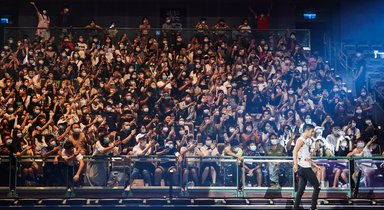Blogs by users
How Can You Host a Successful Virtual Event
By Stephan Cartello • Feb 22, 2021

Virtual events still sound a little futuristic, but they’ve been happening for some time now, since the world’s first livestream brought us nail-biting webcam footage of a coffee maker in mid drip. The streaming pot brewed up millions of views.
In some ways little has changed in 2021. But tech and social media upgrades have opened the door to new ways to connect online, from virtual museum tours to live Q&As with astronauts in space.
Even some of the largest conferences have gone partially or completely digital. Moving events like this online can reduce costs and carbon footprints, and make attendance accessible to a wider audience. In 2018, Coachella’s YouTube livestream brought Beyoncé’s Homecoming to more than 41 million people in more than 232 countries, rather than just the hundreds of thousands in attendance in person.
From live-tweeting to livestreaming, businesses and organizations are staging virtual events across the web. So, is your company ready to get digital?
Whether you have an event already in mind or you’re looking for ideas, we will give you some great advice.
What's considered a virtual event?
A virtual event is any organized meet-up that takes place online rather than in a physical location. These events can range from small question-and-answer sessions to large-scale conferences with thousands of attendees.
We prepared a rundown of the different kinds of online business events your company can host.
How-to’s, product demos, and classes.
Have a product or service that needs some explaining? A how-to or tutorial is a good way to provide tips, tricks, and instructions.
This type of event can be used to launch a new product, answer frequently-asked questions, or reveal different use cases. Kick things up a notch with a full-on class. For instance, fitness trainers or chefs can share exercise and cooking classes online.
Training and courses
For more complex topics, webinars, workshops, and courses might be a better fit. This format can offer deep dives around specific themes, skill sets, tools, and more.
Behind-the-scenes tours
Give your followers a peek behind-the-scenes. Places like museums, galleries, theaters, aquariums, and even national parks, can offer viewers glimpses at what it’s like to visit. Or what it’s like to work somewhere.
Your business doesn’t have to be an attraction to make it happen. Tour your lab, factory, office, workshop, trade show or test kitchen. Show your customers how's sushi being made.
Interviews and performances
Tap your in-house experts to share their knowledge in a live question-and-answer session. Host a laidback Ask Me Anything (AMA) on social media. Or invite speakers or artists to give a talk or performance.
Everything from TED-style talks to stand-up comedy shows or intimate interviews is fair game. Interactive trivia games and contests can also keep things engaging.
Conferences and shows
Even large-scale events can have a virtual component. From Coachella to SXSW to CES, live concerts, summits and event consumer electronics shows have been streamed online so that people who can’t attend in person can still get in on the action. But there are also many conferences that take place entirely online, with networking and meetings integrated, too.
How to host a virtual event
There are a variety of ways to host a virtual event. Here’s a round-up of the different formats along with some of the best tools you can use.
Live tweeting
Start an online discussion by live tweeting an event, asking a question, or hosting an Ask Me Anything. Use a hashtag to help people find and follow the conversation.
Other online discussion tools include:
Discord: Free voice and text chat mostly used by gamers.
Reddit: A discussion forum popular for AMAs (Ask Me Anything).
Slack: An instant-messaging platform good for organizing chats.
Social Stories
Stories are a great platform to share videos and visuals of tutorials, interviews, and more. Add filters, special effects, and stickers to take questions, conduct polls, host an influencer takeover, and more. On Instagram, you can add them to a highlight for future viewers.
This approach to live events works with:
Instagram Stories
Facebook Stories
TikTok
Snapchat
Webinars
Webinar platform options include:
6connex: Available on any browser or device, with no download required. Features include flexible registration, social media integration, and real-time analytics.
Crowdcast: Can be joined through a single URL. Tools include built-in registration forms, analytics, replays, and more.
Demio: Allows for pre-recorded or live webinars—or a mix of both. Includes private chat, interactive polls, call-to-action buttons, and other features.
Livestorm: On-demand webinars from Livestorm include integrations with Google Analytics, Slack, and various engagement tools.
WebinarNinja: No need to download software for this platform, which offers paid and free events, 1,000+ app integrations, and even Facebook Pixel ad tracking.
Zoom: Can have one host, group chat—and even offers breakout rooms. Plans cover from 100 to 10,000 view-only attendees.
YouTube Livestream: A free and easy option for streaming live webinars.
EventCartel: Allows you to live stream your events and webinars. Attendees can chat, purchase merchandise and donate to a host.
Social livestreams
Just about every social media platform has a live video feature. Livestreams are known for driving engagement. According to Facebook, live video averages six times more engagement than regular video.
Social livestream platforms include:
Instagram Live
Facebook Live
LinkedIn Live
TikTok
Twitter Live
YouTube Livestream
Most livestreams show comments and attendees in real time. And some, like Instagram, make it possible for you to go live with a friend—a good option for a Q&A or co-presentation.
Tips for hosting virtual events
All events come with logistical challenges. Here’s how to avoid hiccups during your virtual event.
1. Planning is everything.
Whether big or small, offline or online, every event should have a strategy. Start with a key goal and concept, then take it from there. The earlier you can get planning, the better.
Before hosting a virtual event, answer the following questions:
What kind of experience do you hope to deliver?
Will the event be live, on-demand, or both?
Where do I want the content to be seen?
Will access be gated or free?
When is the best time for the event?
Will you require event registration?
How will you promote the event?
Do you plan to work with an advertiser or other partner?
Will people still have access to the event once it’s over?
2. Timing is crucial
Picking the right date and time for your event is important, regardless of size or platform. Before sending out “save the dates” to your network, do a little research. Make sure there are no competing events or holidays that would interfere with attendance.
Take time zones into consideration, too. If you plan to go global, try your best to pick a time that works for as many of your customers and followers as possible. If that doesn’t seem possible, make sure content is accessible after live presentations for those who couldn’t make it. It may also be worthwhile to plan multiple networking sessions and different virtual events for different time zones.
Check analytics to see when your community is typically online. And for a firmer consensus, consider sending out or posting a poll for preferred dates.
3. Promote the event
“If you build it they will come” may be a fallacy, but “promote it and they will come,” isn’t. Especially when you offer a good incentive.
Determine the key selling points your event has to offer attendees. It could be a great artist, noteworthy speaker, skill sharing, an opportunity to network, and more.
Whatever you choose, make sure the value proposition is clear in your marketing.
Share the event details by email, text and on social media (EventCartel allows you to do all that from your organizer dashboard) If you plan to run ads, target them strategically and choose the right format.
4. Prepare for tech troubles
If physical events have hitches, virtual events have glitches.
Before kicking things off, test your Internet connection—and have your speakers do the same. Prepare backups of visuals and presentations in case a file goes wonky or absent. If possible, run a rehearsal. The sooner you identify problems, the sooner you can identify solutions.
Remember that not all of your guests are tech savvy. Anticipate the troubles people may have by preparing easy to follow guides or FAQs. If you have the resources to provide support, even better. Make sure it’s easy to find where and how to ask for help.
5. Make it inclusive
Just like in-person events, virtual events should be as inclusive and accessible as possible.
Make sure clear language, large fonts, and high colour contrast is used at all touch points—including presentations. Provide captions and visuals where possible for audio, and provide descriptions where possible for visuals.
6. Encourage engagement
It’s simple: If you create opportunities for engagement, your audience will be more engaged. Why? It’s fun to see the outcomes of your engagement.
Here’s a simple example: Ask viewers to submit questions in comments or through a chat tool. Chances are the people who ask questions are going to stick around to see if they get answered. Pro tip: If you do this, make sure to have a moderator assigned to the task of fielding questions.
EventCartel can help you create and promote your virtual events and monetize them. Create and promote real life or virtual events, engage with attendees, and measure performance from one dashboard. Try it for free.
Save
Share
Comment


